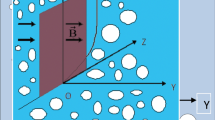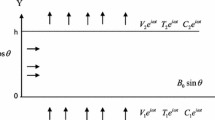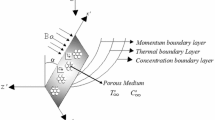Abstract
The current paper scrutinizes the sway of the aligned magnetic field and Kuvshinski fluid model on unsteady MHD free convective flow past a moving inclined plate in the occurrence of thermal radiation as well as radiation absorption with chemical effect and mass blowing or suction. It is implicit that the plate is entrenched in a uniform porous medium moving with a steady velocity in the flow direction and in the existence of a transverse magnetic field. Perturbation technique was employed for solving non-dimensional governing equations. Significant consequences with regard to embedded parameters are illustrated graphically for the temperature, velocity, and concentration profiles. The expression for the Skin friction coefficient is also obtained.
Access provided by Autonomous University of Puebla. Download conference paper PDF
Similar content being viewed by others
Keywords
1 Introduction
There are numerous fluids in the industry as well as technology whose performance fails to be described by the classical linearly viscous Newtonian fluid model. The divergence from the Newtonian comportment demonstrates itself in an assortment of manners: non-Newtonian viscosity, stress relaxation, non-linear creeping, development of normal stress differences, and yield stress. The Navier–Stokes equations are insufficient to prognosticate the activities of such a category of fluids, consequently multitudinous significative associations of non-Newtonian fluids. These substantial relations yields ascend to the differential equations, which, in comprehensive are higher perplexed and higher order compared with Navier–Stokes equations. For that reason, it is complicated to attain exact analytical solutions for Kuvshinski fluids.
Reddy et al. [1] have scrutinized radiation assimilation and Kuvshinski fluid model on unsteady MHD free convective flow all the way through an infinite non-parallel porous plate in the existence of chemical effect and heat source. Sakthikala et al. [2] investigated the influence of Kuvshinski fluid model on unsteady free convective fluid flow through an infinite moving porous plate by means of dependable as well as variable temperatures. Reddy et al. [3] examined the influence of Soret and Kuvshinski type fluid on MHD natural convective flow inside a porous medium through a semi-infinite non-parallel moving plate with heat source. In this examination, perturbation technique was employed for solving the governing equations. Buggaramulu et al. [4] have reported visco-elastic fluid model on unsteady MHD-free convective fluid stream through a porous medium in the existence of chemical effect and radiation.
Devasena et al. [5], Reddy et al. [6] and VidyaSagar et al. [7] have analyzed analytically the influence of Kuvshinski fluid on unsteady MHD natural convective flow with radiation absorption. Sharma et al. [8] have examined influence of stratified Kuvshinski fluid on MHD free convective stream through a non-parallel porous plate by means of heat and mass transfer. Chamkha [9] and Hady et al. [10] have analyzed unsteady natural convective flow through a semi-infinite porous moving plate by means of heat absorption. Hossian et al. [11] have discussed the problem of natural convection flow along a non-parallel wavy surface by means of uniform surface temperature in the existence of heat generation/absorption. Chamkha et al. [12], Muthucumaraswamy et al. [13] and Ibrahim et al. [14] investigated the influence of heat generation and chemical reaction on MHD unsteady free convection flow over perpendicular moving porous plate.
All these studies paid attention towards MHD unsteady free convection flow of Kuvshinski fluid past an inclined surface, where thermal radiation, radiation absorption, chemical reaction, heat generation, and aligned magnetic impacts are contemplated. The predominant purpose is to scrutinize the unsteady MHD free convection flow of Kuvshinski fluid past a moving inclined plate with heat production in the demeanor of mass blowing or suction and with the special effects of aligned magnetic, chemical reaction, thermal radiation, and radiation absorption.
2 Mathematical Formulation
Let us contemplate the 2D unsteady MHD free convection Kuvshinski fluid flow through a semi-infinite inclined moving porous plate in a uniform porous medium under the sway of a uniform magnetic field, radiation absorption, chemical effect, heat generation and thermal radiation. Here x*-axis is taken along the porous plate in the upward direction and y*-axis perpendicular to it. The fluid is to be gray, absorbing—emitting however non-scattering medium. In the x*-way, the radiative heat flux is significantly small against to that in the y*-direction. Each and every flow variable excluding pressure are functions of y* and t* only. The plate in x*-direction is of infinite length. The induced magnetic field is insignificant. The size of the porous plate is large compared to typical microscopic length scale of the porous medium. Chemical reactions occur in the flow.

Under these suppositions, the governing equations are
The conditions at the boundary are
Let us suppose that in the direction of the fluid flow, the porous plate moves by a stable velocity \(u_{p}^{*}\) and the free stream velocity \(U_{\infty }^{*}\) abide by exponentially increasing small perturbation law. In addition, the temperature, concentration and the suction velocity are exponentially varying with time. It is clear from Eq. (1) that the suction velocity at the plate surface is a function of time only and it takes the following form
where A is a real positive constant \(\in\) and \(\in A\) are small and less than unity and V0 is a scale of suction velocity which is a non-zero positive constant.
Let us set the dimensionless variables as follows:
Substituting the Eq. (8) into Eqs. (2), (3) and (4), we obtain
The corresponding boundary conditions are
where, \(N = M\,\sin^{2} \,\xi + \frac{1}{K}.\,{\text{Gr}}_{1} = {\text{Gr}}\,{ \cos }\phi ,\quad {\text{Gm}}_{1} = {\text{Gm}}\,{ \cos }\phi\).
3 Solution of the Problem
To solve the Eqs. (9)–(11) subject to the boundary conditions (12) and (13), we apply the perturbation technique. Let the velocity, temperature and concentration fields as
Using (14) in Eqs. (9)–(11) and comparing the coefficients of the same degree terms and neglecting terms of 0(∈2), a set of ODE are obtained and on solving, the following solutions are obtained.
Shear Stress: The skin friction at the plate y = 0 in terms of shear stress is given by
4 Results and Discussion
From analytical solutions, the numerical values for velocity, temperature, concentration, skin friction, Nusselt number as well as Sherwood number are computed by fixing diverse values of the non-dimensional parameters in the problem, i.e., n = 0.2, A = 1, ε = 0.002, t = 1, S = 0.01, Ra = 1, R = 1, Pr = 0.71, M = 1, Sc = 0.60, Gr = 5, Gm = 3, Kr = 1, Up = 1, K = 5, \(\lambda_{1}\) = 1, \(\phi = \frac{\pi }{6}\) and \(\xi = \frac{\pi }{6}\).
Figure 1 illustrated the effects on velocity of magnetic field M as well as Prandtl number Pr for cooling of the plate (Gr > 0). The velocity declined for both water (Pr = 7) as well as air (Pr = 0.71). The reason is that the magnetic field generates Lorentz force which resists the fluid flow and hence velocity falls. From Fig. 2: it is lucid that the velocity diminishes with the rise of aligned angle \(\xi\) for the reason that the influence of the applied magnetic field is higher while aligned angle accentuates. From Fig. 3, it is observed that fluid velocity decreases with the increase of angle \(\phi\). If the plate is inclined, as a result of gravity components, the buoyancy effect decrements and consequently the fluid has higher velocity for vertical surface (\(\phi\) = 0) as against that of inclined surface. The influence of radiation, heat absorption as well as absorption radiation parameters on the temperature field is revealed in Fig. 4. It is perceived that the temperature rises with the rise in radiation and radiation absorption parameters.
Conclusions
-
The velocity declines, with the incremental values of magnetic field.
-
The temperature rises with the rise in thermal radiation and radiation absorption and the skin friction rise with the rise in solutal Grashof number.
-
The rise of aligned angle or angle of inclination leads to a decrease in fluid velocity (Table 1).
Table 1 Skin friction coefficient when Kr = R = Ra = \(\phi\) = \(\xi\) = \(\lambda_{1}\) = 0
Validation of the results: In this examination, the outcomes obtained herein are compared with the results of Chamkha [9] in the absence of Kr, R and Ra on skin friction τ for different values of Gm. The consequences of this comparison are in good agreement with Chamka [9].
References
Reddy SH, Raju MC, Reddy EK (2015) Unsteady MHD free convection flow of a Kuvshinski fluid past a vertical porous plate in the presence of chemical reaction and heat source/sink. Int J Eng Res Afr 14(1):13–27
Sakthikala R, Prahala S (2018) Heat and mass transfer of unsteady MHD flow of Kuvshinski fluid with heat source/sink and soret effects. Int J Mech Eng Technol 9:1064–1077
Reddy VKRGV, Varma SVK (2016) MHD convection flow of Kuvshinski fluid past an infinite vertical porous plate with thermal diffusion and radiation effects. Chem Mater Res 8(2):18–31
Buggaramulu J, Venkata Krishna M (2017) MHD convection flow of Kuvshinski fluid past an infinite vertical porous plate with radiation and chemical reaction effects. Int J Recent Innov Trends Computing Commun 5(9):64–74
Devasena Y, LeelaRatnam A (2014) Combined influence of chemical reaction, thermo diffusion and thermal radiation on the convective heat and mass transfer flow of a Kuvshinski fluid past a vertical plate. Int J Adv Sci Tech Res 1(4):774–787
Reddy SH, Raju MC, Reddy EK (2015) Unsteady MHD free convection flow of a Kuvshinski fluid past a vertical porous plate in the presence of chemical reaction and heat source/sink. Int J Eng Res Afr 14(3):13–27
VidyaSagar B, Raju MC, Varma SVK, Venkataramana S (2014) Unsteady MHD free convection boundary layer flow of radiation absorbing Kuvshinski fluid through porous medium. Rev Adv Phys Theor Appl 1(3):48–62
Sharma G, Varshney NK (2013) Stratified Kuvshinski fluid effect on MHD free convection flow with heat and mass transfer past a vertical porous plate. Int J Math Arch 4(9):29–34
Chamkha AJ (2004) Unsteady MHD convective heat and mass transfer past a semi-infinite vertical permeable moving plate with heat absorption. Int J Eng Sci 42(1):217–230
Hady FM, Mohamed RA, Mahdy A (2006) MHD free convection flow along a vertical wavy surface with heat generation or absorption effect. Int Commun Heat Mass Transfer 33:1253–1263
Hossain MA, Molla MM, Yao LS (2004) Natural convection flow along a vertical wavy surface with uniform surface temperature in presence of heat generation/absorption. Int J Therm Sci 43(2):157–163
Chamkha AJ (2003) MHD flow of a numerical of uniformly stretched vertical permeable surface in the presence of heat generation/absorption and a chemical reaction. Int Commun Heat Mass Transf 30:413–422
Muthucumaraswamy R, Ganesan P (2001) Effect of the chemical reaction and injection on flow characteristics in an unsteady upward motion of an isothermal plate. J Appl Mech Techn Phys 42(4):665–671
Ibrahim FS, Elaiw AM, Bakr AA (2008) Effect of the chemical reaction and radiation absorption on the unsteady MHD free convection flow past a semi-infinite vertical permeable moving plate with heat source and suction. Commun Non-linear Sci Numer Simul 13:1056–1066
Author information
Authors and Affiliations
Corresponding author
Editor information
Editors and Affiliations
Rights and permissions
Copyright information
© 2021 Springer Nature Singapore Pte Ltd.
About this paper
Cite this paper
Rama Prasad, J.L., Balamurugan, K.S., Varma, S.V.K. (2021). Aligned Magnetic Field Effect on Unsteady MHD Double Diffusive Free Convection Flow of Kuvshinski Fluid Past an Inclined Moving Porous Plate. In: Rushi Kumar, B., Sivaraj, R., Prakash, J. (eds) Advances in Fluid Dynamics. Lecture Notes in Mechanical Engineering. Springer, Singapore. https://doi.org/10.1007/978-981-15-4308-1_20
Download citation
DOI: https://doi.org/10.1007/978-981-15-4308-1_20
Published:
Publisher Name: Springer, Singapore
Print ISBN: 978-981-15-4307-4
Online ISBN: 978-981-15-4308-1
eBook Packages: EngineeringEngineering (R0)








